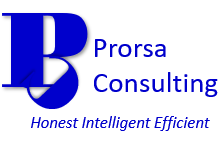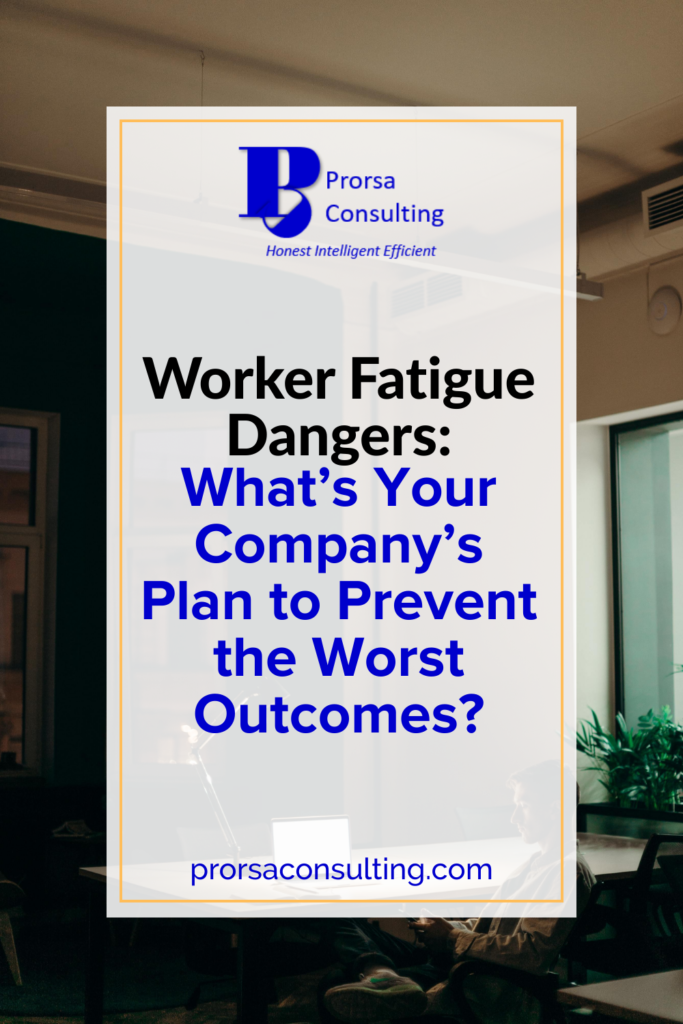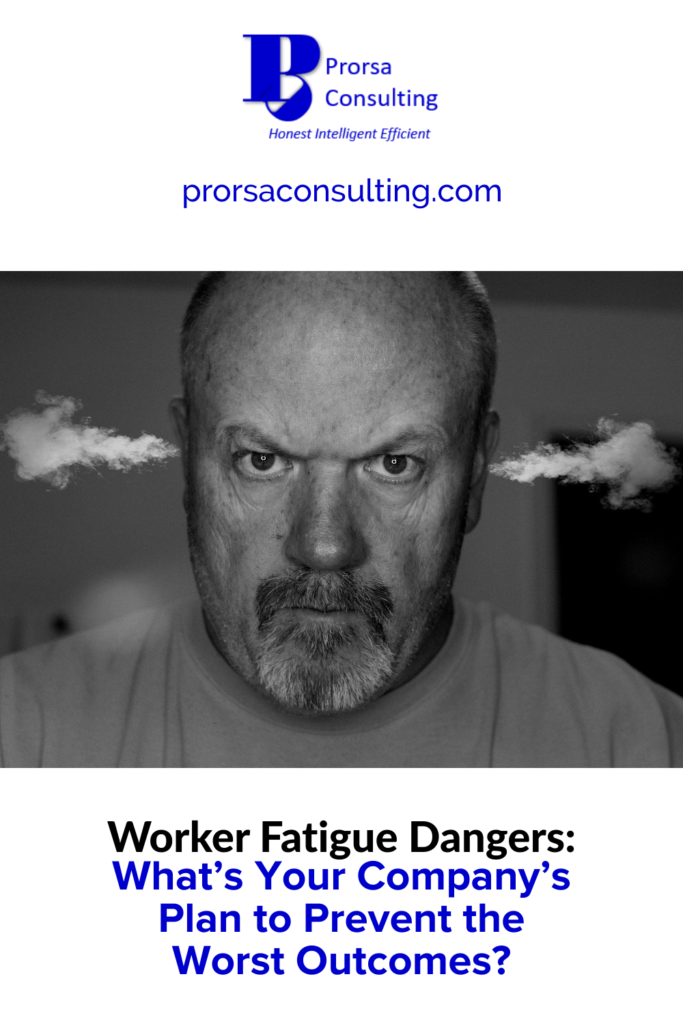Worker Fatigue Dangers: What’s Your Company’s Plan to Prevent the Worst Outcomes?
By : Admin -
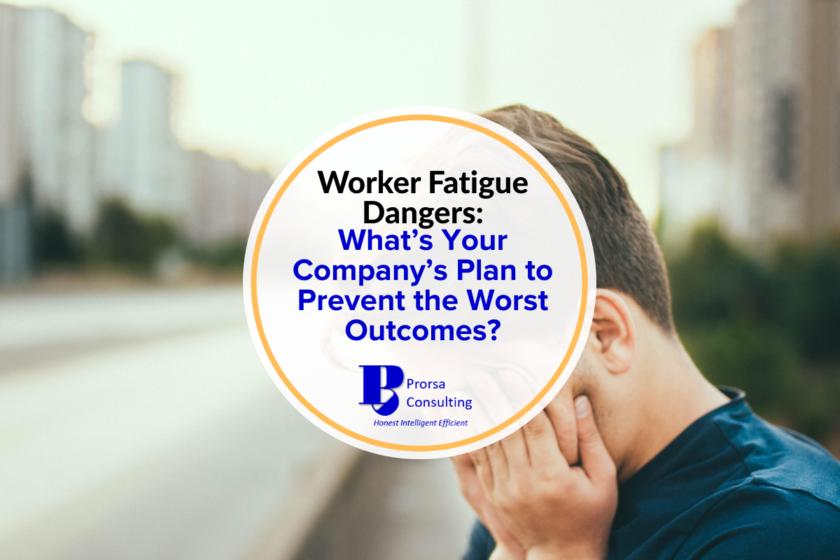
Worker fatigue dangers often go unnoticed in the workplace.
Most individuals are unaware of the long-term toll too much work with too little rest can have on the body. The cultural messages of success at all costs and our go-go-go, do-do-do lifestyles only create more significant worker fatigue dangers. Additionally, few workplace safety programs address these issues.
The National Safety Council states, “Fatigued worker productivity costs employers $1,200 to $3,100 per employee annually.” However, employers possess the capability to mitigate the effects of fatigue in the workplace. With good monitoring and prevention strategies in place, companies can stop workplace fatigue in its tracks.
5 Worker Fatigue Dangers Organizations Should Recognize
Fatigued employees display poor decision-making and judgment.
A couple of nights with poor sleep can result in fuzzy thinking. Without clarity of thought, one lacks the proper analytical capacity to recognize unsafe conditions or behaviors. Alternatively, an employee exhibiting work fatigue symptoms may fall into the trap of complacency because nothing terrible has happened out of sheer luck.
The above scenarios cause workers to make the wrong call when faced with potentially hazardous situations. For example, the individual might misjudge the danger involved with performing a task they are untrained to do. Furthermore, a person suffering from fatigue may decide to take shortcuts because their body and mind would rather not be bothered with performing the task properly.
A lack of focus also appears on the list of worker fatigue dangers.
The workplace houses a multitude of potential hazards. Employees must be attentive to their surroundings to protect themselves adequately. The tiniest lapse in focus could result in injury to oneself or others.
Focus deficits cause attention to falter. When that happens, a person may lose their place during a task or not see the warning signs of potential danger around them. Additionally, workers’ minds may wander, and they may be unable to refocus before encountering a potential hazard.

Image by dusanpetkovic1 on stock.adobe.com.
The dangers of fatigue also include slower reaction times.
The body uses sleep to repair itself. As such, a lack of rest can slow one’s physical responses. Our ability to perform tasks like driving, operating machinery, typing, and even getting dressed can suffer when reactions to external stimuli decrease.
In the workplace, slowed reaction time may impair an individual’s ability to avoid potential dangers. Moreover, a worker may not be able to perform tasks requiring quick reflexes or body movements. Employees’ productivity can also suffer as a result of diminished physical response.
Workers’ moods may signal fatigue in the workplace.
Sleep affects how humans feel emotionally. We have all had mornings after a good night’s rest when we thought we could conquer the world. Individuals with sleep deprivation often exhibit temperamental, irritable behavior.
Moody employees are less likely to accept directions at work. Furthermore, any perceived slight or criticism could easily provoke anger. Minor misunderstandings could quickly escalate to considerable disagreements or even violence.
You cannot talk about worker fatigue dangers without discussing decreased physical capacity.
Excellent sleep is necessary for optimal health. Poor or lacking sleep negatively affects all the systems of the body. Without adequate, quality repair time, a person leaves themselves more susceptible to disease, unable to correct previous damage to cells, and with waning energy.
So, what does this mean for workers? A fatigued employee may lack the energy to complete work or even keep themselves awake. Likewise, individuals’ muscles may not possess the strength necessary to accomplish some duties. Finally, workers’ inferior physical condition could lead to higher absenteeism rates, affecting workplace productivity.
The Good News . . . Businesses Can Implement Fatigue Management in the Workplace
Companies should integrate fatigue prevention into their safety and health programs and systems.
Organizations can better combat work fatigue symptoms when they manage these hazards as part of an established scheme. Therefore, businesses should include the effects of fatigue in the workplace and prevention strategies in their health and safety programs.
Companies should train workers about workplace fatigue and provide reinforcement communications during regularly scheduled meetings and toolbox talks. Businesses should strive to make healthy sleep a part of the health and safety culture by discouraging work-related activities outside of regular working hours and arming employees with information to promote their best sleep.
Furthermore, businesses should evaluate and optimize their employee schedules to mitigate worker fatigue dangers.
Individuals who work overnight or on rotating shifts are incredibly vulnerable to sleep issues because they fight their natural sleep cycle. Even people working long hours each day may find it challenging to get enough rest.
Employers can assist their workforce by limiting overnight work and not changing employees’ schedules unless necessary. Additionally, companies can set daily work hour maximums and ensure workers take their scheduled breaks during the workday.

Image by Ron Lach on pexels.com.
Workers and supervisors should monitor for the symptoms of fatigue at work.
Employees often alert employers to potential hazards in the workplace. Their roles should be the same when it comes to worker fatigue dangers. Workers should self-monitor for fatigue and take appropriate steps to resolve issues. Additionally, employees should be encouraged to speak with their supervisor if they notice fatigue symptoms in others that are negatively impacting the work environment.
Supervisors must stay alert for worker fatigue within their teams and mitigate the impacts on safety. Individuals who supervise others should reinforce fatigue safety tips to the workforce. Furthermore, supervisors should be given the authority to enact mandatory time off for any employee with suspected fatigue whose behavior is putting themselves, others, or the operations at risk. Supervisors may need to consider disciplinary action for workers who refuse to address fatigue issues.
Organizations should encourage employees to seek help to promote their best sleep.
Many resources exist to help workers foster the healthy sleep needed for excellent fatigue management in the workplace. Online resources like Brigham and Women’s Hospital Sleep Education page or the American Academy of Sleep Medicine’s Sleep Education website can assist workers in building the best routine for good sleep.
Certain physical and mental diseases can put individuals at greater risk for developing sleep problems. As such, some individuals may need professional intervention to manage fatigue effectively. In these cases, employers should encourage workers to seek the advice of medical and mental health professionals for proper care.
Additional Safety Management Posts for You
Take Workplace Violence out of the Mainstream
Robust Personal Risk Assessment in 4 Powerful Acts
How to Craft an Informative EHS Awareness Program for Continued, High-Value Business Wins
6 Hot EHS Trends to Explore in 2024
Final Words on Worker Fatigue Dangers
Fatigue presents a hazard to employees while in the workplace. Organizations that recognize the signs and encourage employees to take preventative steps stand the best chance of mitigating work fatigue symptoms before an injury occurs.
We encourage your feedback on this blog. So, like, comment, and share below if you enjoyed this post. You can also provide your thoughts to us via our Contact Us page.
Follow Prorsa Consulting on LinkedIn, Pinterest, and Twitter!
Prorsa Consulting helps businesses assess, maintain, and improve environmental and safety compliance to lower business risk and positively impact bottom lines. Schedule a discovery call and begin the journey to stellar EHS performance.
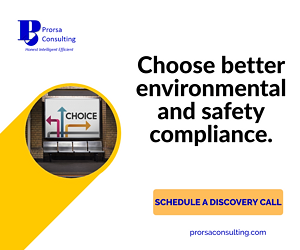
Access to additional EHS information and resources from Prorsa Consulting awaits you. Subscribe to Prorsa’s Newsletter below for our exclusive subscriber-only content. You’ll also gain access to the tools, templates, and presentations housed in our Free Resources area. Take advantage of this free subscription now!
